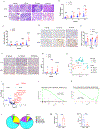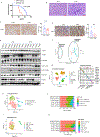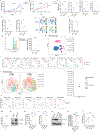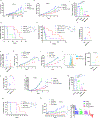KRAS Inhibition Activates an Actionable CD24 "Don't Eat Me" Signal in Pancreatic Cancer
- PMID: 40966362
- PMCID: PMC12515478
- DOI: 10.1158/0008-5472.CAN-25-2024
KRAS Inhibition Activates an Actionable CD24 "Don't Eat Me" Signal in Pancreatic Cancer
Abstract
KRASG12C inhibitors (G12Ci) have produced encouraging, albeit modest and transient, clinical benefit in pancreatic ductal adenocarcinoma (PDAC). Identifying and targeting resistance mechanisms to G12Ci treatment is therefore crucial. To better understand the function of KRASG12C and possible G12Ci bypass mechanisms, we developed an autochthonous KRASG12C-driven PDAC model. Compared to the classical KRASG12D PDAC model, the G12C model exhibits slower tumor growth, yet similar histopathological and molecular features. Aligned with clinical experience, G12Ci treatment of KRASG12C tumors produced modest impact despite stimulating a 'hot' tumor immune microenvironment. Immunoprofiling revealed that CD24, a 'don't eat me' signal, is significantly upregulated on cancer cells upon G12Ci treatment. Blocking CD24 enhanced macrophage phagocytosis of cancer cells and significantly sensitized tumors to G12Ci treatment. Similar findings were observed in KRASG12D-driven PDAC. Together, this study reveals common and distinct oncogenic KRAS allele-specific biology and identifies a clinically actionable adaptive mechanism that may improve the efficacy of oncogenic KRAS inhibitor therapy in PDAC.
Figures




Update of
-
KRAS Inhibition Activates an Actionable CD24 "Don't Eat Me" Signal in Pancreatic Cancer.bioRxiv [Preprint]. 2025 Sep 13:2023.09.21.558891. doi: 10.1101/2023.09.21.558891. bioRxiv. 2025. Update in: Cancer Res. 2025 Sep 18. doi: 10.1158/0008-5472.CAN-25-2024. PMID: 37790498 Free PMC article. Updated. Preprint.
References
-
- Hunter JC, Manandhar A, Carrasco MA, Gurbani D, Gondi S, Westover KD. Biochemical and Structural Analysis of Common Cancer-Associated KRAS Mutations. Mol Cancer Res 2015;13:1325–35. - PubMed
Grants and funding
LinkOut - more resources
Full Text Sources
Miscellaneous

